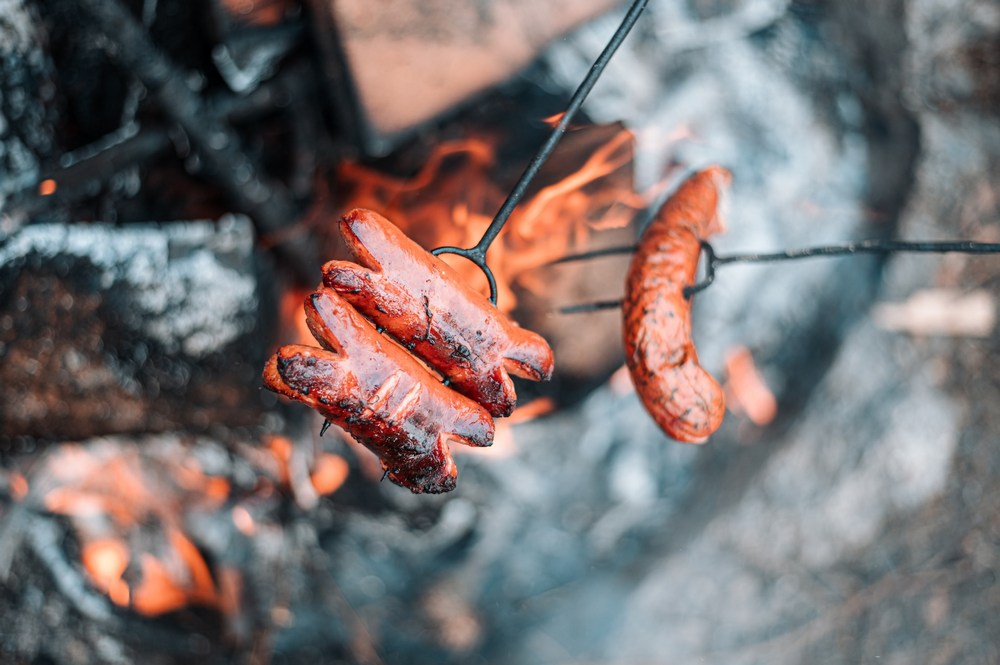The aroma of sizzling sausages fills the air, making your mouth water in anticipation. Whether you’re grilling in your backyard or cooking sausages over a campfire, you know you’re in for a treat. But what are the key differences between these two methods, and how do you choose the best sausage for each occasion? In this article, we’ll explore the flavors that come with grilling and campfire cooking, tips for selecting the perfect sausage, and the art of pairing your sausages with the right accompaniments. So grab your tongs and gather around the fire as we embark on a culinary journey through the world of sausages
Grilled Sausage vs. Campfire Sausage: Flavor Differences
When it comes to flavor, both grilled and campfire sausages have their unique characteristics. Grilled sausages are typically cooked on a gas or charcoal grill, allowing for precise temperature control and even cooking. This method often results in a juicy sausage with a crispy, caramelized exterior, thanks to the Maillard reaction, which occurs when proteins and sugars are exposed to high heat.
On the other hand, campfire sausages are cooked over an open flame, giving them a distinct smoky flavor that many people find irresistible. The heat from the fire can be more challenging to regulate, resulting in a more rustic, charred exterior. The wood used in the campfire can also contribute to the sausage’s flavor, with different types of wood imparting unique taste notes.
Both methods have their advantages, and the preferred cooking method often comes down to personal taste. Some may prefer the controlled, caramelized flavor of grilled sausages, while others may be drawn to the smoky, charred taste of campfire-cooked sausages. Ultimately, it’s up to you to decide which method best suits your palate.
Selecting the Perfect Sausage for Grilling
When it comes to grilling, not all sausages are created equal. To ensure a delicious and satisfying grilled sausage experience, consider the following factors:
- Quality: Always opt for high-quality sausages made from fresh, well-sourced ingredients. Look for sausages with a high meat content and avoid those filled with excessive amounts of fillers, preservatives, or artificial flavors.
- Type: There are countless sausage varieties to choose from, and selecting the right one for grilling can be a matter of personal preference. Some popular options include Bratwurst, Italian sausage, Chorizo, Kielbasa, and Andouille. Each has its unique flavor profile and will pair differently with accompaniments and condiments.
- Casing: Natural casings, made from animal intestines, are preferred for grilling because they offer a better snap and texture when bitten into. Synthetic casings can be used, but they may not provide the same level of satisfaction.
- Size and thickness: Sausages come in various sizes and thicknesses, which can affect cooking times and the final texture. Thicker sausages may require more time on the grill to cook through, while thinner sausages will cook faster. Consider the preferences of your guests and your desired level of doneness when selecting the perfect sausage for grilling.
- Flavorings and seasonings: Some sausages come pre-seasoned or pre-marinated, making them ready for grilling without any additional preparation. When selecting a flavored sausage, consider how the seasonings will interact with your chosen accompaniments and condiments to create a harmonious and delicious dish.
By considering these factors, you can select the perfect sausage for grilling that will satisfy your taste buds and impress your guests.
Choosing the Ideal Sausage for a Campfire
Cooking sausages over a campfire is an enjoyable outdoor experience, but selecting the right sausage is crucial for a delicious result. When choosing sausages for campfire cooking, consider the following factors:
- Quality: As with grilling, opt for high-quality sausages made from fresh, well-sourced ingredients. Lower-quality sausages with excessive fillers or preservatives may not cook well over an open flame and can compromise the overall taste.
- Type: Some sausages are better suited for campfire cooking than others. Robust, flavorful sausages such as Kielbasa, Bratwurst, or Andouille are popular choices. These sausages can withstand the intense heat and open flame, and their bold flavors complement the smokiness of the campfire.
- Casing: Natural casings are preferred for campfire cooking, as they provide a better texture and snap when bitten into. Synthetic casings can be used, but the results may not be as satisfying.
- Size and thickness: Choose sausages that are not too thin, as thinner sausages may cook too quickly over an open flame and become dry or overcooked. Opt for medium to thick sausages that can withstand longer cooking times and retain their juiciness.
- Pre-cooked vs. raw: Pre-cooked sausages can be a convenient option for campfire cooking, as they require less time over the flame and carry a lower risk of undercooking. However, raw sausages can provide a more authentic campfire experience and may offer more control over the final texture and doneness.
- Flavorings and seasonings: Select sausages with seasonings that will complement the smoky flavors imparted by the campfire. Bold, flavorful sausages work well in this setting, but milder sausages can also be enhanced with the addition of herbs, spices, or marinades.
By keeping these factors in mind, you can choose the ideal sausage for your campfire cooking experience, resulting in a delicious and memorable meal under the stars.

Tips for Grilling Sausages to Perfection
Grilling sausages can be a culinary delight, but there are a few tips to keep in mind to ensure your sausages turn out perfectly cooked and full of flavor:
- Preheat the grill: Allow your grill to preheat for at least 10-15 minutes before placing the sausages on it. A hot grill will help to sear the sausages quickly, locking in their juices and creating a flavorful crust.
- Control the heat: Grilling sausages over medium heat is ideal, as it allows the sausages to cook through without burning the outside. If your grill has temperature zones, consider setting up a cooler zone where you can move the sausages to finish cooking if they start to char too much.
- Avoid piercing the sausages: Resist the temptation to poke or pierce the sausages while they cook, as this can release their juices and result in a drier, less flavorful sausage. Instead, use tongs to gently turn the sausages and prevent sticking.
- Turn sausages frequently: To ensure even cooking and browning, turn the sausages every few minutes, being careful not to squeeze or press them.
- Use a meat thermometer: To ensure your sausages are cooked to a safe internal temperature, use a meat thermometer to check for doneness. Most sausages should be cooked to an internal temperature of 160°F (71°C) for pork and beef or 165°F (74°C) for poultry.
- Allow sausages to rest: Just like other meats, sausages benefit from a brief resting period after cooking. Allow the sausages to rest for a few minutes after they come off the grill, which will help to redistribute their juices and improve their overall texture.
- Be mindful of flare-ups: Fatty sausages can cause flare-ups on the grill. Be prepared to move the sausages to a cooler part of the grill or use a spray bottle with water to douse the flames if needed.
By following these tips, you’ll be well on your way to grilling sausages to perfection, impressing your guests and delighting your taste buds.

Cooking Sausages Over a Campfire: Techniques and Tricks
Cooking sausages over a campfire can be a fun and flavorful experience, but it requires some skill and attention to achieve the best results. Here are some techniques and tricks to help you master campfire sausage cooking:
- Use indirect heat: Rather than cooking sausages directly over the flames, place them near the fire where they can receive indirect heat. This method will help prevent burning and allow the sausages to cook more evenly.
- Build a two-zone fire: Create a two-zone fire by placing hot coals on one side of the fire pit and leaving the other side empty. This setup allows you to cook the sausages over the hot coals for a sear and move them to the cooler side to finish cooking without burning.
- Utilize a grill grate or skewers: If you have a portable grill grate, place it over the campfire to create a stable cooking surface for your sausages. Alternatively, you can skewer the sausages and hold them over the fire or lay them across a couple of logs or rocks on either side of the fire pit.
- Turn sausages frequently: To ensure even cooking, turn the sausages often using tongs or a fork (if they’re skewered). This will help prevent charring and ensure they cook evenly on all sides.
- Be patient: Cooking sausages over a campfire can take longer than grilling, so be patient and allow the sausages to cook slowly and evenly. Rushing the process can result in unevenly cooked or burnt sausages.
- Use a meat thermometer: Just like with grilling, use a meat thermometer to check the internal temperature of the sausages to ensure they’re cooked to a safe temperature. Aim for 160°F (71°C) for pork and beef sausages or 165°F (74°C) for poultry sausages.
- Rest before serving: Allow the sausages to rest for a few minutes after cooking to redistribute their juices and improve their overall texture.
By following these techniques and tricks, you’ll be able to enjoy perfectly cooked sausages over a campfire, enhancing your outdoor culinary experience and creating lasting memories with friends and family.
The Art of Pairing Sausages with Condiments
Pairing sausages with the right condiments can elevate your grilled or campfire sausage experience to new heights. Here are some tips and ideas for selecting condiments that complement the unique flavors and characteristics of various sausage types:
- Classic combinations: Some sausages have traditional condiment pairings that have stood the test of time. For example, Bratwurst is often served with mustard and sauerkraut, while Italian sausages are frequently paired with marinara sauce and sautéed peppers and onions.
- Balance flavors: When choosing condiments, consider the flavor profile of the sausage and aim for a balance. If the sausage is spicy, pair it with something cooling, like sour cream or yogurt-based sauce. If the sausage is rich and fatty, a tangy or acidic condiment, like pickles or relish, can help cut through the richness.
- Complement regional tastes: Certain sausages have regional flavors that can be enhanced with condiments native to that area. For instance, Andouille sausage, with its Cajun roots, pairs well with Creole mustard or a spicy remoulade sauce.
- Experiment with gourmet options: Elevate your sausage experience by trying gourmet condiments like artisanal mustards, specialty ketchups, or unique relishes. These can add a touch of sophistication to your grilled or campfire sausages.
- Consider texture: Condiments can also provide contrasting textures that enhance the overall experience. For example, a crunchy slaw can add an interesting contrast to a juicy, tender sausage.
- Don’t be afraid to mix and match: Get creative and try different condiment combinations. You might discover a new favorite pairing that brings out the best in your chosen sausage.
By carefully selecting and pairing condiments with your sausages, you can create mouthwatering dishes that will impress your guests and make your grilled or campfire sausage experience even more enjoyable.
Must-Try Sausage Toppings for Grilling and Campfires
In addition to condiments, various toppings can enhance the flavors and textures of your grilled or campfire sausages. Here are some must-try toppings to consider for your next sausage feast:
- Caramelized onions: Sweet, tender caramelized onions are a classic topping that pairs well with many sausage types, adding a depth of flavor and a touch of sweetness.
- Sauerkraut: This tangy, fermented cabbage is a traditional accompaniment to German sausages like Bratwurst, but it can also complement other sausage varieties, providing a pleasant acidic contrast.
- Grilled peppers: Charred, smoky grilled peppers add a delicious layer of flavor and texture to sausages, especially when paired with Italian sausages or Chorizo.
- Pickled vegetables: Pickled vegetables like cucumbers, jalapeños, or red onions can add a tangy, crunchy element to your sausages, balancing the richness and fat content.
- Cheese: Melted cheese, such as Swiss, cheddar, or provolone, can add a creamy, gooey element to your sausages, enhancing their indulgence.
- Fresh herbs: Chopped fresh herbs like cilantro, parsley, or basil can add a burst of fresh flavor and a pop of color to your sausages, especially when combined with other toppings and condiments.
- Bacon: For an extra layer of savory, smoky flavor, wrap your sausages in bacon before grilling or cooking over a campfire. The bacon will crisp up and add a delightful crunch.
- Pineapple salsa: For a sweet and tangy twist, try topping your sausages with a refreshing pineapple salsa made from diced pineapple, red onion, jalapeño, cilantro, and lime juice. This topping works especially well with spicy sausages.
- Coleslaw: A crunchy, tangy coleslaw made from shredded cabbage, carrots, and a vinegar or mayonnaise-based dressing can add a satisfying contrast to your sausages.
- Chili: Top your grilled or campfire sausages with a hearty chili for a robust, filling, and flavorful dish that’s perfect for outdoor gatherings.
By experimenting with these must-try toppings, you can create unique and delicious sausage dishes that will impress your guests and make your grilled or campfire sausage experience even more memorable.
Natural Seasonings for Grilled and Campfire Sausages
Natural seasonings can enhance the flavors of your grilled or campfire sausages without relying on processed condiments. Here are some suggestions for using natural herbs, spices, and other ingredients to add depth and complexity to your sausages:
- Fresh herbs: Chopped fresh herbs such as rosemary, thyme, oregano, or sage can be sprinkled onto sausages before grilling or cooking over a campfire, adding an aromatic and fresh flavor.
- Garlic: Minced garlic or garlic powder can be used to season sausages, providing a bold and savory taste that complements many sausage types.
- Smoked paprika: For a smoky, earthy flavor, sprinkle smoked paprika onto your sausages before cooking. This seasoning works particularly well with sausages that have a natural smokiness, such as Kielbasa or Andouille.
- Crushed red pepper flakes: If you enjoy a bit of heat, add crushed red pepper flakes to your sausages for a spicy kick.
- Ground cumin: Cumin adds a warm, earthy flavor that pairs well with sausages, particularly those with a Middle Eastern or Mexican influence.
- Fennel seeds: Fennel seeds are a common ingredient in Italian sausages, but you can also sprinkle them onto other sausage varieties for a hint of licorice-like sweetness.
- Lemon zest: For a bright, citrusy touch, grate some lemon zest over your sausages before grilling or cooking over a campfire.
- Mustard seeds: Whole mustard seeds or ground mustard powder can be used to season sausages, adding a tangy, pungent flavor that pairs well with many sausage types.
- Sea salt and freshly ground black pepper: Don’t forget the basics – a simple seasoning of sea salt and freshly ground black pepper can enhance the natural flavors of your sausages without overpowering them.
- Marinades: Create natural marinades using ingredients like olive oil, lemon juice, garlic, and fresh herbs to infuse your sausages with flavor before grilling or cooking over a campfire.
By incorporating these natural seasonings into your grilled or campfire sausage preparation, you can elevate the taste and enjoy a more wholesome, delicious meal.
The Role of Marinades in Enhancing Sausage Flavor
Marinades play a significant role in enhancing the flavor and texture of sausages, whether they’re cooked on a grill or over a campfire. A well-crafted marinade can accomplish several things:
- Flavor infusion: A marinade can penetrate the surface of the sausages, infusing them with the flavors of the marinade ingredients. This allows you to introduce a variety of tastes, such as spicy, sweet, tangy, or herbaceous, depending on the components of the marinade.
- Tenderization: Marinades that contain acidic ingredients like vinegar, lemon juice, or wine can help to tenderize the sausages by breaking down their proteins. This can result in a more tender and succulent texture when cooked.
- Moisture retention: Marinades containing oil help to seal in moisture, which can be especially beneficial when cooking sausages over high heat, such as on a grill or campfire. The oil in the marinade creates a barrier that helps to prevent the sausages from drying out during cooking.
- Caramelization: Ingredients with natural sugars, like honey, maple syrup, or brown sugar, can promote caramelization when the sausages are cooked. This results in a delicious, slightly sweet crust on the exterior of the sausages.
- Balance of flavors: A well-crafted marinade can strike a balance between the various flavors it contains, creating a harmonious blend that enhances the natural taste of the sausages without overpowering them.
To create an effective marinade for sausages, consider the following tips:
- Choose a base: Start with a base of oil, such as olive oil, canola oil, or avocado oil, which will help to retain moisture during cooking.
- Add acidity: Incorporate an acidic component like vinegar, citrus juice, or wine to help tenderize the sausages.
- Season with herbs and spices: Add herbs, spices, and aromatics to the marinade for flavor infusion. Some popular options include garlic, rosemary, thyme, oregano, chili flakes, cumin, and smoked paprika.
- Incorporate sweeteners (optional): If you desire a hint of sweetness and caramelization, consider adding a natural sweetener like honey, maple syrup, or brown sugar.
- Marinate for an appropriate amount of time: Allow the sausages to marinate for at least 30 minutes to a few hours to ensure the flavors have time to penetrate the meat.
By understanding the role of marinades in enhancing sausage flavor and crafting your own unique marinade recipes, you can elevate your grilled or campfire sausages to a whole new level of deliciousness.
Side Dishes to Complement Your Grilled or Campfire Sausage
Choosing the right side dishes can complement and enhance the flavors of your grilled or campfire sausages. Here are some side dishes that pair well with sausages, offering a balanced and satisfying meal:
- Potato salad: A classic potato salad with a creamy or tangy dressing can complement the richness of sausages and provide a cooling contrast to spicy varieties.
- Grilled vegetables: Grilled vegetables like zucchini, eggplant, bell peppers, and asparagus offer a healthy, flavorful accompaniment to sausages, enhancing the overall grilled or campfire experience.
- Baked beans: Baked beans, whether homemade or store-bought, provide a hearty, flavorful side dish that pairs well with many sausage types.
- Coleslaw: A tangy, crunchy coleslaw made with shredded cabbage and carrots adds a refreshing contrast to the richness of sausages, balancing the flavors and textures of the meal.
- Corn on the cob: Grilled or boiled corn on the cob, seasoned with butter and spices, complements the smoky flavors of grilled or campfire sausages.
- German-style potato pancakes: These crispy, savory potato pancakes, known as Kartoffelpuffer, are a traditional accompaniment to sausages in Germany and can add a delicious, satisfying element to your meal.
- Caprese salad: A simple Caprese salad with fresh tomatoes, mozzarella, basil, and a drizzle of balsamic glaze offers a light, refreshing side dish that pairs well with flavorful sausages.
- Macaroni and cheese: A creamy, comforting macaroni and cheese can provide a delicious, indulgent contrast to the bold flavors of sausages.
- Mixed green salad: A simple mixed green salad with a tangy vinaigrette can balance the richness and fat content of sausages, providing a lighter, healthier option.
- Roasted or grilled mushrooms: Flavorful roasted or grilled mushrooms can complement the earthy, savory notes of many sausage types, enhancing the overall taste experience.
By selecting side dishes that complement and balance the flavors of your grilled or campfire sausages, you can create a satisfying, well-rounded meal that will delight your taste buds and impress your guests.









